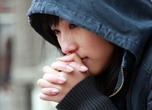
Illustration by Haruna Nitadori
Posted: Wed Jul 20 2011
Exactly four months on from the March 11 disaster, I find myself sitting down to lunch with Hiroko Tabuchi. In the wake of the catastrophe, the young New York Times journalist quickly established herself as one of the must-follow Tweeters involved in the crisis, offering level-headed, 'no-bullshit' commentary in a way that readers came to rely upon. She wasn't the only one, of course, but there was a poetry in her backstory that intrigued me. I'd been trying to set up an interview ever since.
Originally from the Nagata area of Kobe, Hiroko was 15 when the Great Hanshin Earthquake levelled the city in 1995. Mutual friends told me that it spurred her into becoming a journalist, though she says she already had the career in mind ('either a journalist or an aid worker; I was leaning toward being an aid worker, actually'). However, I was keen to know how a teenage Kobe survivor viewed the Tohoku situation through adult – and professional – eyes. Furthermore, I wondered if, as someone who has made repeated trips to the affected region, she was able to discern any progress in an area crippled by natural disasters and further hobbled by political infighting. As ever, Hiroko Tabuchi had a lot to say.
Thinking back, what was it that you wanted most immediately after the Kobe earthquake?
Heat. The Kobe earthquake also happened in the middle of winter, in January, the coldest part of the year. All the power went out. People just came out with their futons wrapped around them. I remember being cold all the time and wanting something warm to eat…just a bowl of something hot.
What you saw after this earthquake must have brought back a lot of memories.
Yes, although tsunami damage is very different from earthquake damage. With tsunami damage, it's such a stark dividing line between where the tsunami reached and where it didn't. You can be on one street, but if the tsunami stopped there, then all the houses on one end of the street would be fine, and all those on the other end would be completely washed away.
The disaster news seems to have slipped out of foreign headlines. How do you feel about that?
It's difficult, having seen how long it took to Kobe to recover. People say Kobe had a miraculous recovery, though it took at least a decade. I'm actually from the worst hit part of Kobe, Nagata, which was complete burnt down. They used to have a lot factories famous for shoes, but they were destroyed in huge fires there. I remember going back to Nagata for the tenth anniversary and seeing that very few of the factories had come back. A lot of the area just became car parks. People just didn't have the money to rebuild, so Kobe lost that industry. It just never came back.
Do you think Tohoku will suffer a similar fate?
There was a series of photos that went around, maybe a month ago, showing areas of Tohoku immediately after the quake and then again now; first huge amounts of debris, now all cleaned up. That is progress in a way, but the thing is, in Kobe, and now in Tohoku too, recovery is what comes after cleaning up, if people are able to rebuild their lives. And that takes them 10 years, 20 years.
One of the things that struck me is that Ishinomaki and Kesennuma were areas that were, in a sense, dying towns anyway. The population was plummeting long before the tsunami...
Right. I mean, are people going to go back? Are there going to be any jobs again? I think it really depends on what the government can do to bring jobs back to that region. And I mean sustainable jobs. Of course there are going to be construction jobs, a lot of them, because all of these buildings have to be rebuilt. But what can the government do to bring sustainable recovery? I think before they do anything, the government needs to send out a very clear message, some sort of plan for the area. Maybe they could say that Tohoku is going to be a centre for a renewable energy initiative – so expect jobs there! Right now, I think we are still waiting for a credible plan from the government. And I think there was a sense right after the disaster when we thought this could be a moment for Japan, when everyone rallies round a common mission; when we could've said, 'this is an emergency and we're gonna do things differently – let's work together now.' But, unfortunately, I feel like that sense is slipping away. And it's sad because a lot of this feeling came from the younger people, who are often said to be apathetic, and suddenly there were people saying 'What can I do? I want to volunteer.' More people were aware of what's going on, watching the news, which young people don't don't necessarily do so much here. Japan's politicians could have harnessed that energy, but that didn't happen.
Did you spend much time in Fukushima?
I spent the first weeks after the quake covering the nuclear crisis from Tokyo, so the first time I went to Tohoku was a month later. I've taken four trips to Fukushima now.
What's it like entering the zone?
Oh, I didn't enter the zone! Older male journalists did, but I wouldn't. I'm sure some female journalists would be more committed, but I didn't because I want to have kids someday and I don't want to do anything to jeopardize that. I'm serious! I mean, call me paranoid, but I made that choice. I did report from Fukushima City, and some of the areas there have radiation level readings as high as the areas they evacuated. It's a city of 300,000 people. If it were smaller, I think parts of it would've been evacuated.
What's life like there?
It's very strange. There's a strange kind of dual reality, which I tried to put across in my story. Some people are going about business not wearing masks, drinking the water, eating the food, really criticising the people that are scared; saying they're bringing a bad name to Fukushima with their paranoia. But there's the other group, including a lot of mothers, who are very scared. They're keeping a close watch on radiation levels everyday, not letting their kids drink milk or tap water, who are ordering vegetables from outside the prefecture, wearing masks all the time. It's often very antagonistic. Sometimes there's even confrontation, for example at PTA meetings where some families just want things to get back to normal, and others are scared. But the effects of radiation are very hard to determine, so it's very difficult to know which side is right. It's a matter of the risks you're willing to live with.
What can they do, the people that are so scared?
Well one woman I spoke to was contemplating moving her family to Hokkaido. But in everyday life they don't let their kids play outside; a lot of mothers don't let their kids eat the school lunches because they don't know where the ingredients came from, so they make them take their own bentos. They have to keep their windows closed and wear masks.
And further north? What changes are you seeing up there?
Well, I'd never been to Kesennuma before the tsunami, so it's hard for me to tell. To my eyes, there are areas that still look like the tsunami just hit, but the locals tell me that a lot of the debris has been cleared away; that it's a lot better than it was. There are still areas flooded, where the water has been unable to recede, and because of that there's an unbelievable smell. An acrid smell. Kesennuma got the worst of things because there were fish processing factories that got destroyed, and all the fish in their freezers got thrown out, so there's the smell of rotting fish. At the same time, there were oil tanks in Kesennuma, so all this oil fell into the water. So it's this mix of fish, oil and stagnant water. I was walking around the port, and if I made the mistake of breathing through my nose, I'd just retch. And then there are all the flies…rebuilding is going to be a long process.
Follow Hiroko Tabuchi on her Twitter account: @HirokoTabuchi
Tags:
Tweets
- About Us |
- Work for Time Out |
- Send us info |
- Advertising |
- Mobile edition |
- Terms & Conditions |
- Privacy policy |
- Contact Us
Copyright © 2014 Time Out Tokyo

















Add your comment